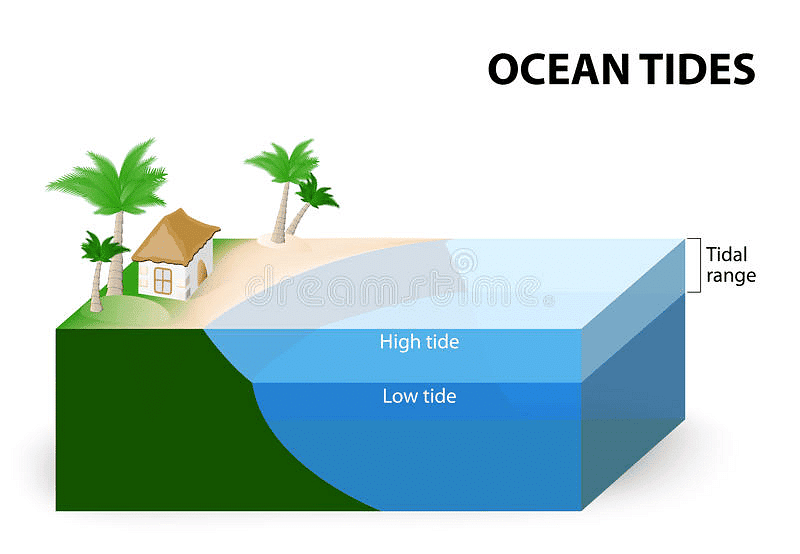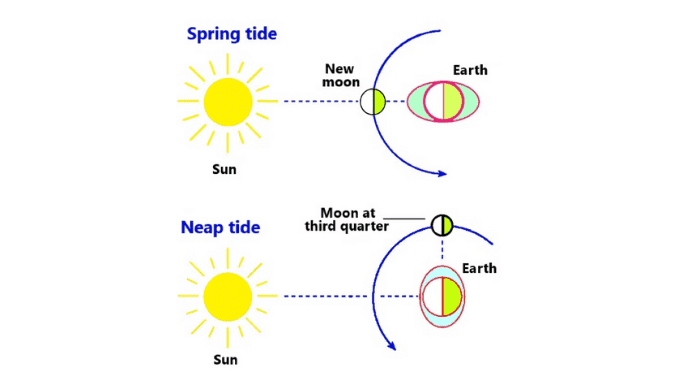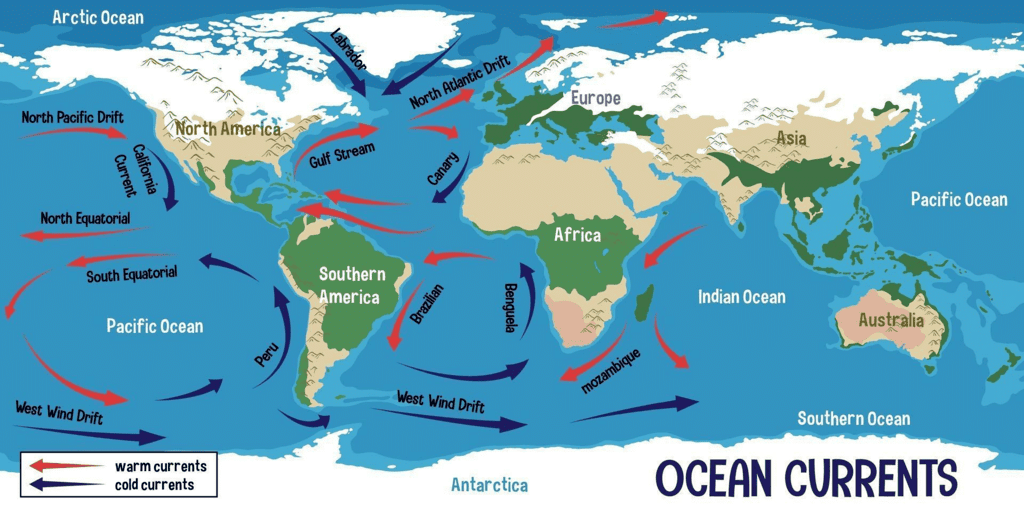UPSC Exam > UPSC Notes > Geography for UPSC CSE > NCERT Summary: Movements of Ocean Water
NCERT Summary: Movements of Ocean Water | Geography for UPSC CSE PDF Download
| Table of contents |

|
| Introduction |

|
| Waves |

|
| Tides |

|
| Ocean Currents |

|
Introduction
- The horizontal motion in oceans comprises ocean currents and waves. Ocean currents involve the continuous flow of a large volume of water in a specific direction, while waves represent the horizontal movement of water.
- Water travels between locations through ocean currents, whereas waves do not transport water; instead, wave trains progress.
- Vertical motion pertains to the rise and fall of water in oceans and seas. The sun and the moon's gravitational pull cause the ocean water to rise and fall twice daily. Additionally, vertical water movements include the upwelling of cold water from subsurface layers and the sinking of surface water.
Waves

- Waves consist of energy traveling across the ocean surface rather than water itself.
- During a wave's passage, water particles move in small circular motions. Wind imparts energy to waves.
- Wind induces wave movement in oceans, releasing energy upon reaching shorelines.
- Surface water motion minimally affects the stationary deep ocean bottom. As waves approach the shore, they decelerate due to friction between dynamic water and the seabed.
- When water depth is less than half the wavelength of a wave, it breaks.
- The largest waves are observed in open ocean areas, with waves growing in size as they absorb wind energy during movement.
- Light winds (up to two knots) over calm water lead to the formation of small ripples, which evolve into white caps as wind speed increases.
Characteristics of Waves
- Wave crest and trough: The highest and lowest points of a wave are known as the crest and trough, respectively.
- Wave height: This is the vertical distance from the trough's bottom to the crest's top.
- Wave amplitude: It constitutes half of the wave height.
- Wave period: Simply put, it is the time gap between two consecutive wave crests or troughs passing a fixed point.
- Wavelength: The horizontal span between two successive crests.
- Wave speed: The pace at which a wave travels through water, typically measured in knots.
[Intext Question]
Tides
- Tides refer to the periodic rise and fall of sea levels, occurring once or twice daily, primarily due to the gravitational pull exerted by the sun and the moon.
- Surges, caused by meteorological factors like winds and atmospheric pressure shifts, involve the movement of water. Unlike tides, surges lack regularity.
- The principal reasons for tides are the gravitational forces of the moon and, to a lesser extent, the sun.

Tides in the Bay of Fundy, Canada
- Highest Tides in the World
- Tidal Bulge Height: 15-16 meters
Types of Tides
Tides based on Frequency
- Semi-diurnal tide : The most common tidal pattern, featuring two high tides and two low tides each day. The successive high or low tides are approximately of the same height.
- Diurnal tide : There is only one high tide and one low tide during each day. The successive high and low tides are approximately of the same height.
- Mixed tide : Tides having variations in height are known as mixed tides. These tides generally occur along the west coast of North America and on many islands of the Pacific Ocean.
Tides based on the Sun, Moon and the Earth Positions
The height of rising water (high tide) varies appreciably depending upon the position of sun and moon with respect to the earth. Spring tides and neap tides come under this category:

- Spring tides: The position of both the sun and the moon in relation to the earth has direct bearing on tide height.
- When the sun, the moon and the earth are in a straight line, the height of the tide will be higher.
- These are called spring tides and they occur twice a month, one on full moon period and another during new moon period.
- Neap tides: Normally, there is a seven day interval between the spring tides and neap tides.
- At this time the sun and moon are at right angles to each other and the forces of the sun and moon tend to counteract one another.
- The Moon’s attraction, though more than twice as strong as the sun’s, is diminished by the counteracting force of the sun’s gravitational pull.
Importance of Tides
- Since tides are caused by the earth-moon-sun positions which are known accurately, the tides can be predicted well in advance.
- This helps the navigators and fishermen plan their activities. Tidal flows are of great importance in navigation.
- Tidal heights are very important, especially harbours near rivers and within estuaries having shallow ‘bars’ at the entrance, which prevent ships and boats from entering into the harbour.
- Tides are also helpful indesilting the sediments and in removing polluted water from river estuaries.
- Tides are used to generate electrical power (in Canada, France, Russia, and China).
Tidal Flows
- This information is crucial for navigators and fishermen to plan their activities effectively.
- Tidal heights play a significant role, particularly for harbors located near rivers and estuaries with shallow 'bars' at the entrance, which can obstruct the passage of ships and boats.
- Tides assist in desilting sediments and purifying polluted water in river estuaries.
- Tidal energy is harnessed for electricity generation in countries like Canada, France, Russia, and China.
- For instance, a 3 MW tidal power project is underway at Durgaduani in the Sunderbans of West Bengal, India.
[Intext Question]
Ocean Currents
- Ocean currents resemble rivers flowing within the oceans, carrying a consistent volume of water along a specific path.
- These currents are shaped by two types of forces: primary forces initiating water movement and secondary forces influencing the flow.
- The primary forces include heating by solar energy, wind, gravity, and the Coriolis force.
- Solar heating causes water to expand, creating a slight gradient leading to water flow, as observed near the equator.
- Wind interacts with the ocean surface, propelling water movement due to friction effects.
- Gravity contributes to gradient variations, pulling water downward.
- The Coriolis force deflects water to the right in the northern hemisphere and to the left in the southern hemisphere.

Characteristics of Ocean Currents
- Large accumulations of water and the flow around them are known as Gyres.
- Differences in water density impact the vertical mobility of ocean currents.
- Currents are identified by their "drift."
- Typically, currents are most vigorous near the surface, reaching speeds exceeding five knots. At greater depths, currents move more slowly, usually less than 0.5 knots.
- The speed of a current is measured in knots, and its strength is determined by its speed.
Types of Ocean Currents
Based on Depth:
- Surface currents: These constitute approximately 10% of the ocean's water, occupying the upper 400 meters. Deep water currents form the remaining 90% of ocean water.
- Ocean currents in both categories move within ocean basins due to density and gravity variations.
Based on Temperature:
- Cold currents: Transport cold water into warmer regions. For example, they are commonly found along the west coasts of continents in low and middle latitudes.
- Warm currents: Bring warm water into colder areas. These currents are typically observed along the east coasts of continents in low and middle latitudes. In the northern hemisphere, warm currents are prevalent on the west coasts of continents in higher latitudes.
Major Ocean Currents
- Major ocean currents are primarily influenced by prevailing winds and the Coriolis force.
- The pattern of oceanic circulation closely mirrors the Earth's atmospheric circulation.
- In middle latitudes, air circulation over oceans is predominantly anticyclonic, with a stronger effect in the southern hemisphere.
- Monsoon winds in regions with pronounced monsoonal flow affect current movements.
- Due to the Coriolis force, warm currents from low latitudes veer to the right in the northern hemisphere and to the left in the southern hemisphere.
- Oceanic circulation transfers heat between different latitude belts, akin to how the atmosphere's general circulation moves heat.
- Cold waters from the Arctic and Antarctic circles migrate towards warmer tropical and equatorial regions, while warm waters from lower latitudes move poleward.
Effects of Ocean Currents
- Ocean currents exert various direct and indirect impacts on human activities.
- Coastlines on the west of continents in tropical and subtropical latitudes (excluding near the equator) are bordered by cooler waters.
- The world's prime fishing areas are predominantly located in these mixing zones.
- Although fog may be present, these areas are generally arid.
- The interaction of warm and cold currents aids in oxygen replenishment and promotes plankton growth, crucial for fish populations.
- These regions typically experience cool summers and relatively mild winters, with a narrow temperature range throughout the year.
[Intext Question]
The document NCERT Summary: Movements of Ocean Water | Geography for UPSC CSE is a part of the UPSC Course Geography for UPSC CSE.
All you need of UPSC at this link: UPSC
|
175 videos|624 docs|192 tests
|
Related Searches




















